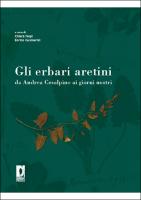Gli erbari aretini da Andrea Cesalpino ai giorni nostri
| dc.contributor.editor | Nepi, Chiara | |
| dc.contributor.editor | Gusmeroli, Enrico | |
| dc.date.accessioned | 2022-05-31T10:14:48Z | |
| dc.date.available | 2022-05-31T10:14:48Z | |
| dc.date.issued | 2008 | |
| dc.identifier | ONIX_20220531_9788884538031_126 | |
| dc.identifier.issn | 2704-6044 | |
| dc.identifier.uri | https://library.oapen.org/handle/20.500.12657/54842 | |
| dc.language | Italian | |
| dc.relation.ispartofseries | Cataloghi e collezioni | |
| dc.subject.other | Biologia | |
| dc.subject.other | Botanica | |
| dc.subject.other | Arezzo | |
| dc.subject.other | Museo di storia naturale | |
| dc.subject.other | Firenze | |
| dc.title | Gli erbari aretini da Andrea Cesalpino ai giorni nostri | |
| dc.type | book | |
| oapen.abstract.otherlanguage | The production of this book has been made possible by the collaboration of a number of scholars and the generosity of the Arezzo Provincial Authority. It provides detailed descriptions of the contents of precious botanical collections amassed by natives of Arezzo, or simply conserved in institutions situated within the territory. The book provides an overview of both herbals of dried plants and painted herbals from the sixteenth century up to the present, starting from the one created in 1563 by the Arezzo doctor Andrea Cesalpino. The first herbal in the world to be organised through systematic criteria, this collection is now in the Botanical Section of the Florence University Museum of Natural History, together with another small eighteenth-century herbal produced by a pharmacist from Cortona, Agostino Coltellini. Conserved in Cortona itself is another eighteenth-century herbal, this one painted by Mattia Moneti, while in Castiglion Fiorentino and Poppi respectively are the intriguing collections of the Hortus siccus pisanus (18th century) and of the Biblioteca Rilliana (late 17th century). Also described in the book is a herbal from the Convent of La Verna (18th century) and the Egyptian herbal of Jacob Corinaldi (19th century), conserved in Montevarchi. Finally there are also the modern herbals, illustrating the continuity over time of a practice that is the foundation of all systematic study. The book is in fact rounded off by an anastatic reprint of the description of the Cesalpino herbal published in 1858, which is still a seminal work for studies such as those contained in this collection. | |
| oapen.identifier.doi | 10.36253/978-88-8453-803-1 | |
| oapen.relation.isPublishedBy | bf65d21a-78e5-4ba2-983a-dbfa90962870 | |
| oapen.relation.isbn | 9788884538031 | |
| oapen.relation.isbn | 9788855188593 | |
| oapen.relation.isbn | 9788884537652 | |
| oapen.series.number | 4 | |
| oapen.pages | 208 | |
| oapen.place.publication | Firenze |

